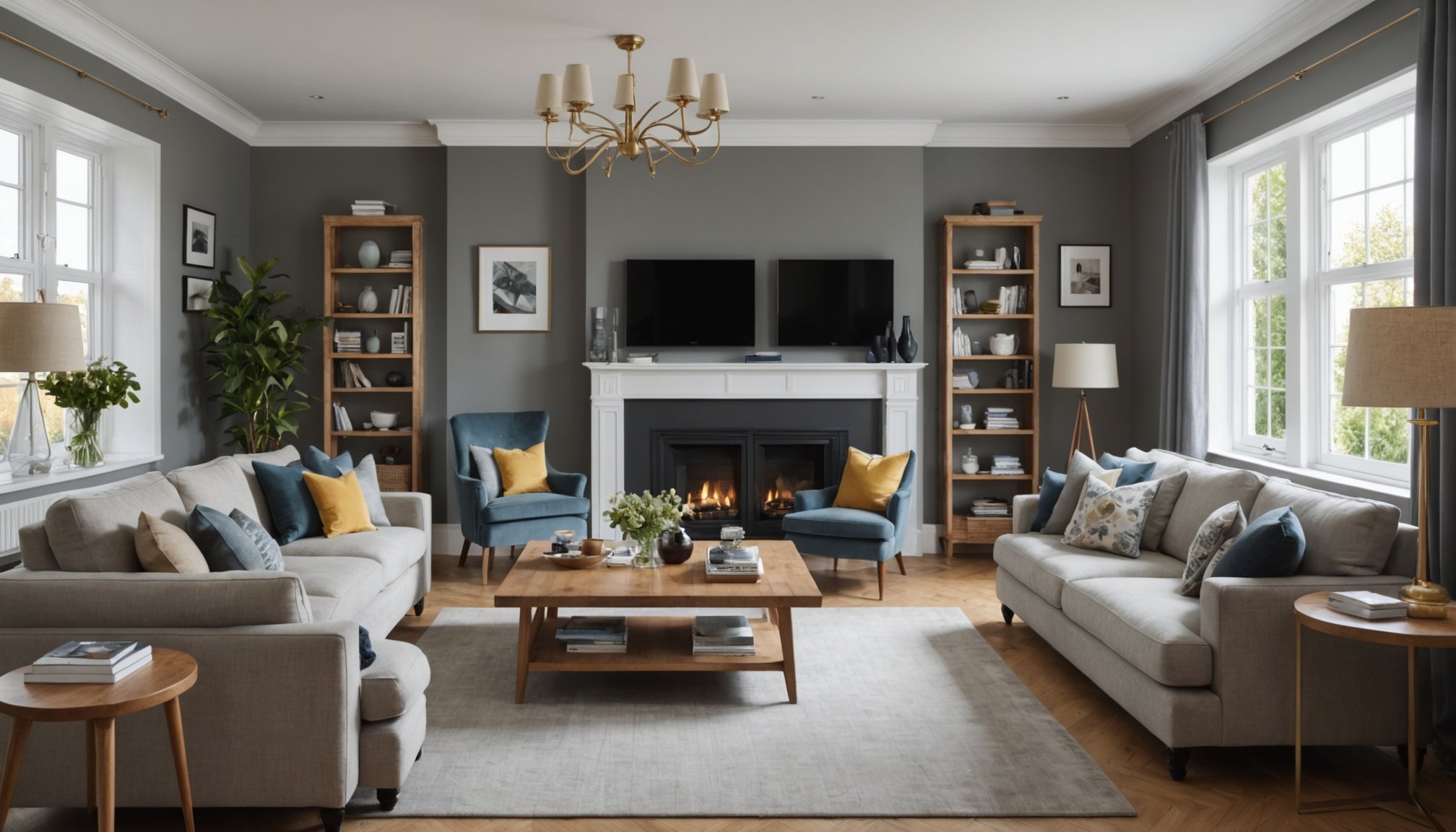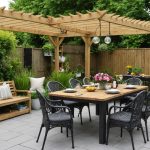Understanding the Importance of a Floor Plan
A floor plan serves as a crucial blueprint for enhancing your living space. It influences how spaces are used and can significantly impact daily life. By accurately laying out a home’s design, a floor plan ensures that each room fulfills its intended purpose efficiently. This, in turn, leads to an improved lifestyle as movement within the house becomes intuitive.
The significance of a floor plan extends to how furniture is arranged. Effective furniture arrangements ensure that rooms are not congested and that residents have enough space to move around easily. Moreover, this arrangement can facilitate better interaction within a household, making common areas more welcoming and personalised. The placement of furniture should always consider the floor plan to maintain balance and functionality.
A lire également : Essential Tips for Safely Packing and Moving Your Rare Home Library in the UK
A well-crafted floor plan provides numerous benefits, including enhancing aesthetic appeal and increasing a property’s value. It also aids in optimising energy use by allowing natural light to enter strategic areas. Choosing the correct floor plan can fundamentally improve your quality of life by adapting the environment to your needs. Understanding this can encourage more informed decisions when selecting or designing a home.
Analyzing Your New Home’s Space
Before falling in love with a new home, it’s essential to assess the living space effectively. This process ensures you make the most of your new abode and avoid any surprises later on.
A lire également : Ensuring Seamless Medication Management During Moves Between UK Health Districts
Dimensions and Layout
Start by understanding the dimensions and layout of each room. Measure each space accurately to determine if your current furniture will fit or if new arrangements need consideration. A well-organized layout facilitates efficient use of space and enhances daily living.
Architectural Features
Next, identify architectural features that might influence how you use the space. Elements like alcoves, bay windows, and built-in storage can significantly affect furniture placement and room functionality. Recognizing these features early allows for more creative design solutions and avoids potential hurdles down the line.
Natural Light and Flow
Finally, evaluate the sources of natural light and overall traffic flow within the home. Consider how sunlight enters each room at different times of the day, as this can impact energy efficiency and mood. Moreover, observe the movement patterns in your living space to ensure a smooth, uninterrupted flow, which ultimately enhances comfort and accessibility throughout your new home.
Tools and Software for Floor Plan Creation
In the realm of floor planning tools, innovation and technology play crucial roles. From streamlined software to convenient apps, these tools are designed to transform the way we plan and visualise spaces. Amongst the various software options, some well-established names include SketchUp, AutoCAD, and RoomSketcher. These are recognised for their robust functionalities and user-friendly interfaces, making them accessible to both novices and experts in floor plan design.
Digital floor planning offers significant advantages over traditional manual methods. Firstly, digital tools make it easier to adjust dimensions and redesign layouts on the fly. This flexibility reduces time and effort, allowing users to experiment with various design configurations without starting from scratch. Additionally, digital tools often come with features like automated measurement tools and 3D visualisation, providing a more comprehensive understanding of the space.
For those seeking simplicity and efficiency, there are various apps tailored to floor planning on the go. Notable recommendations include MagicPlan and Floorplanner, praised for their intuitive interfaces and accessibility on mobile devices. These apps offer features such as real-time editing and easy sharing with clients or collaborators, making them ideal choices for both professional and personal projects.
Step-by-Step Guide to Creating Your Floor Plan
Creating a floor plan involves a clear and structured approach. By understanding each phase of the floor plan creation process, you can achieve a design that perfectly fits your needs.
Gathering Necessary Measurements
Before you grab your pencil, ensure you have all necessary measurements. Use a tape measure to capture the length and width of each room. Measure door frames, windows, and any structural features. Accurate measurements are vital to avoid any discrepancies in your design. Remember, precision is key to an effective floor plan.
Initial Sketching
With your measurements in hand, begin with a rough sketch. This preliminary sketch helps visualize the layout and spatial arrangements. Use graph paper for simplicity, marking out essentials like furniture placement and functional zones. Initial sketching is a visual brainstorming tool—creative but not yet finalised.
Finalizing the Layout
Refining your floor plan is the final step in the floor plan creation process. Take your rough sketch and feedback to adjust spacing, room sizes, and dedicate spaces efficiently. Use design software to transform your initial ideas into a polished plan. Essential tips for finalising include keeping traffic flow in mind and ensuring all functional aspects are proportionally represented.
Following these steps will streamline the designing and planning of any space, ensuring a well-executed and functional design.
Best Practices for Furniture Arrangement
Creating a well-arranged space involves a balance between aesthetics and functionality. When considering furniture arrangement tips, it’s essential to prioritise both the maximisation of space and the ease of movement. Begin by understanding the primary function of the room. This defines the purpose, whether it’s a living area for relaxation or a dining space for gatherings.
Strategies for Maximizing Space and Functionality
Adopt a layout that encourages flow and harmony. Opt for multi-functional furniture to enhance utility without overcrowding. For instance, a foldable table can be a dining surface and a workspace. Position larger pieces, like sofas, against walls to free up central areas, making the room feel more spacious.
Importance of Balancing Aesthetics and Practicality
Achieving a visually appealing area requires mindful planning. Choose colour schemes and materials that align with your personal style yet remain easy to maintain. Ensure that your choices do not compromise the practicality. Good lighting can accentuate the room’s best features while making the space comfortable and inviting.
Common Mistakes to Avoid in Furniture Placement
Avoid pushing all furniture against the walls, as it can create a boxed-in appearance. Overloading a room with furniture is another pitfall that leads to clutter and restricts movement. Always consider how each piece interacts with others and the overall space. This thoughtful planning can enhance both the utility and the aesthetic appeal of your home.
Specific Considerations for UK Housing
Understanding the nuances of UK housing layout is crucial when designing interiors or planning renovations. Homes in the UK often have unique characteristics that distinguish them from those in other countries.
Standard Room Sizes
UK homes typically feature compact room sizes, especially in urban areas. Standard living rooms might span around 12×15 feet, while bedrooms often range from 9×12 feet for a single room. This sizing plays a significant role in determining furniture selection and arrangement.
Popular Styles and Trends
In recent years, open-plan living has gained popularity, reflecting a shift towards more social and functional spaces. This trend maximizes space efficiency and natural light, fostering a sense of openness. Traditional English decor also remains ingrained in the country’s housing styles, favouring timeless pieces and earthy colour palettes.
Adapting to Smaller Spaces
Adapting to smaller living areas can be a rewarding challenge. Employing space-saving furniture like foldable tables and beds with storage compartments can make a world of difference. Reflective surfaces and light colours enhance the perception of space, and vertical storage solutions fully utilise available height, offering practical storage without encroaching on floor space. This tactful approach ensures compact homes remain stylish and functional.
Visual Examples and Case Studies
In the realm of interior design and functionality, understanding successful floor plan examples is crucial. To visualize the potential of a space, consider case studies where furniture arrangements have been optimally executed. These studies provide real-world instances where clever placements contribute to both aesthetics and utility.
One such example showcases a small apartment transformed through strategic furniture positioning. By using compact furniture and multi-purpose pieces, the limited area feels larger and remains functional. Such layouts offer inspiration for maximising space without sacrificing style or comfort.
Analysis of Different Room Configurations
Exploring various room configurations can highlight the versatility in floor plan examples. For instance, a living room with an open floor plan encourages social interaction, while a closed plan might offer privacy, ideal for focused activities. Understanding the purpose and arrangement helps in choosing the right design approach.
Visual layouts for inspiration are pivotal when contemplating a room’s potential. These diagrams offer clear guidance on how to arrange furniture in a way that balances aesthetics with practicality. Adopting these layouts not only enhances comfort but also efficiency, ensuring spaces are welcoming and purposeful.
Therefore, harnessing the power of visual examples and well-studied case studies serves as a guide for anyone eager to maximise their living spaces effectively.
Additional Organization Tips
Achieving a well-organized home often involves strategic planning and thought-out home organization strategies. One essential aspect is creating dedicated areas within a space for specific activities.
Creating Functional Zones
To effectively manage your home, consider the importance of zoning. By assigning different zones or areas for particular activities, you promote both order and functionality. For instance, a reading nook, a workspace, or a family entertainment space can be constructed using furniture arrangement and room dividers. This not only maximizes the available area but also ensures that each function has its own designated space, reducing clutter and chaos.
Utilizing Storage Solutions
Storage solutions play a crucial role in maintaining a well-organized home. Effective storage can include furniture with hidden compartments, shelving units, and labeled boxes or baskets. These assets aid in keeping items neatly stowed away and make retrieval easy, ensuring that everything has a home. This approach helps maintain tidiness and streamlines daily routines.
Personalizing Your Space
While organization is important, personalizing your space adds comfort and style. Incorporate elements that reflect your character, such as artwork, textiles, and decor that appeal to you. Personal touches not only make your space uniquely yours but also enhance its overall ambience, creating a welcoming and harmonious environment.











